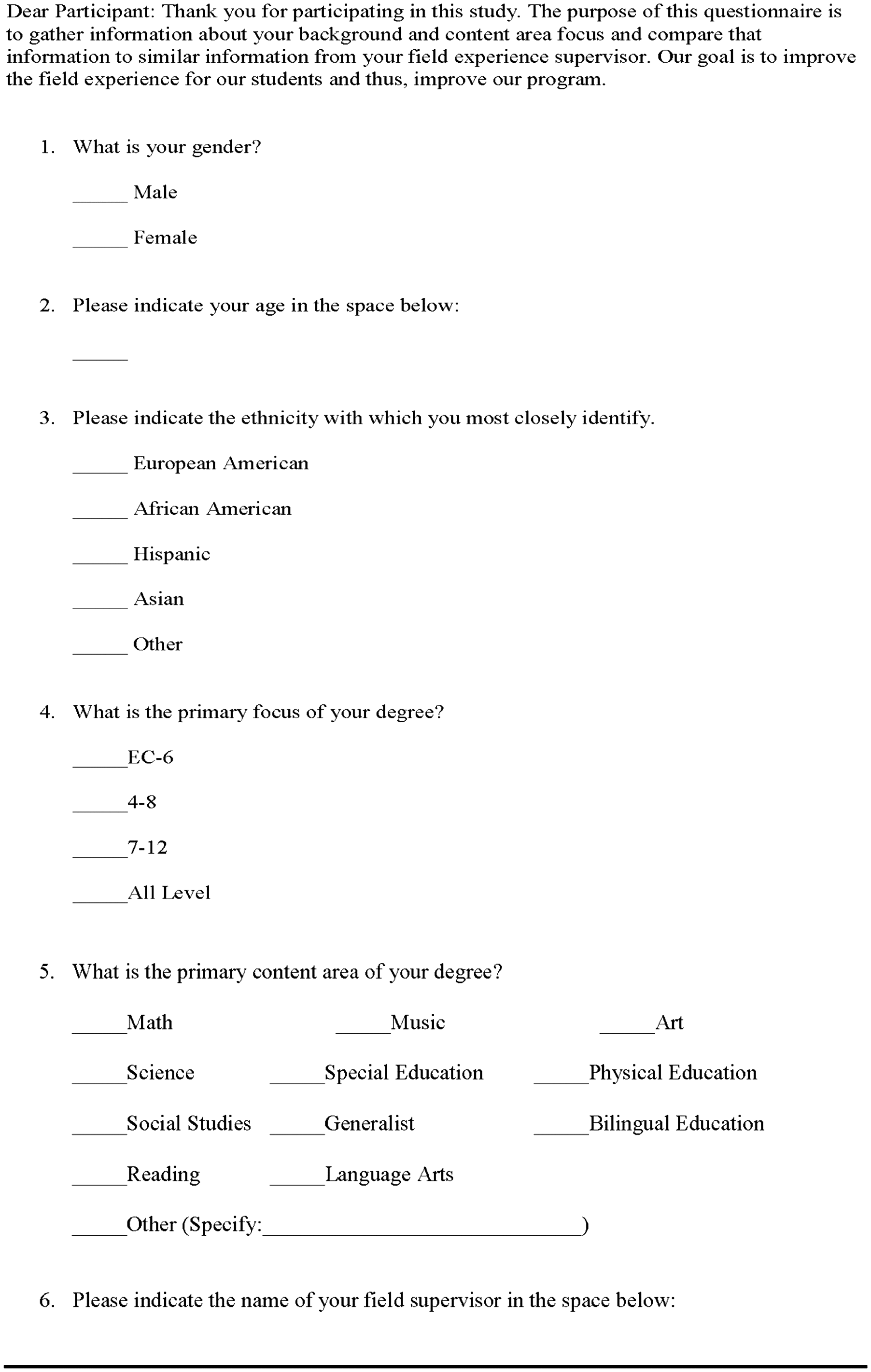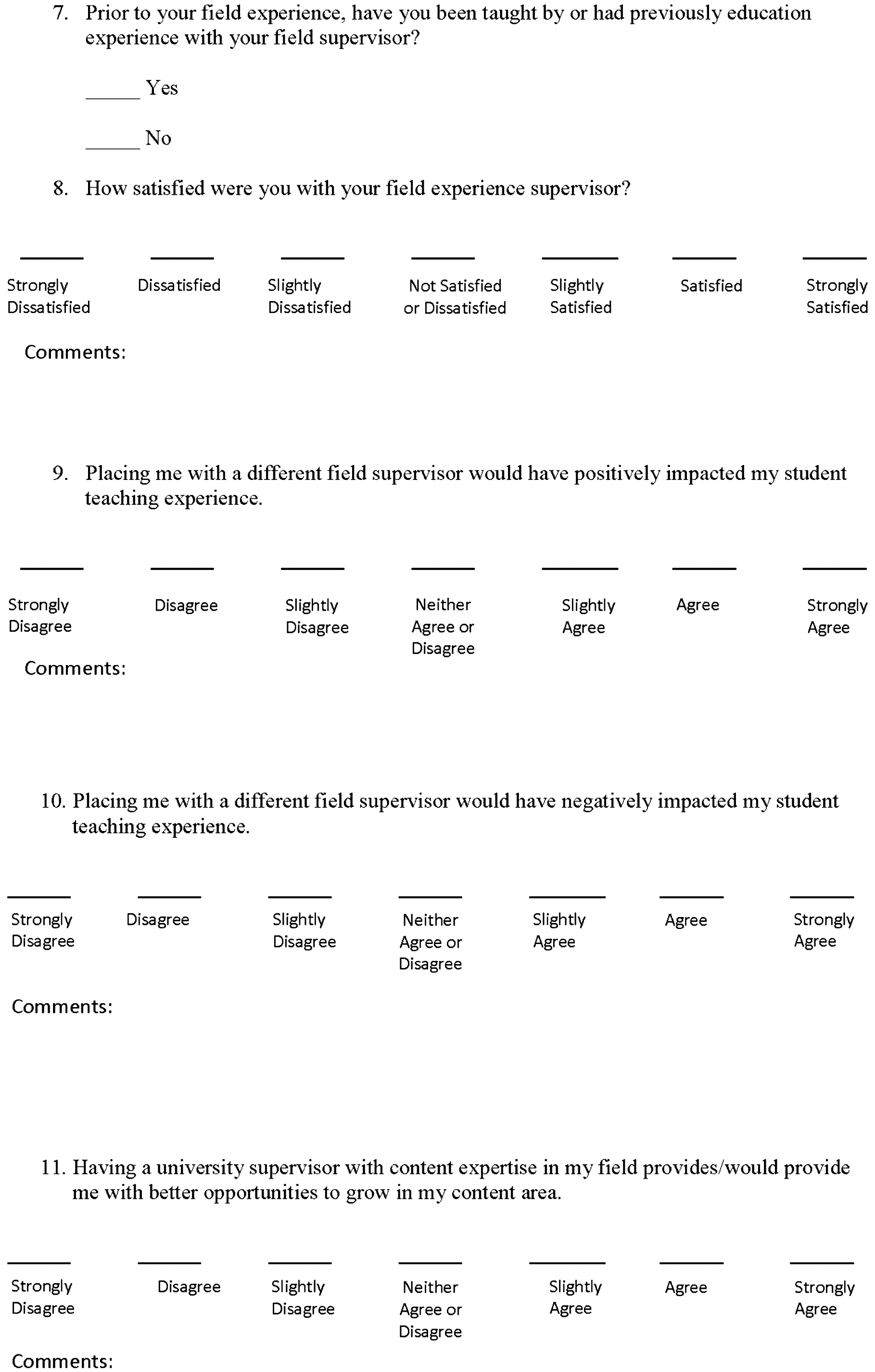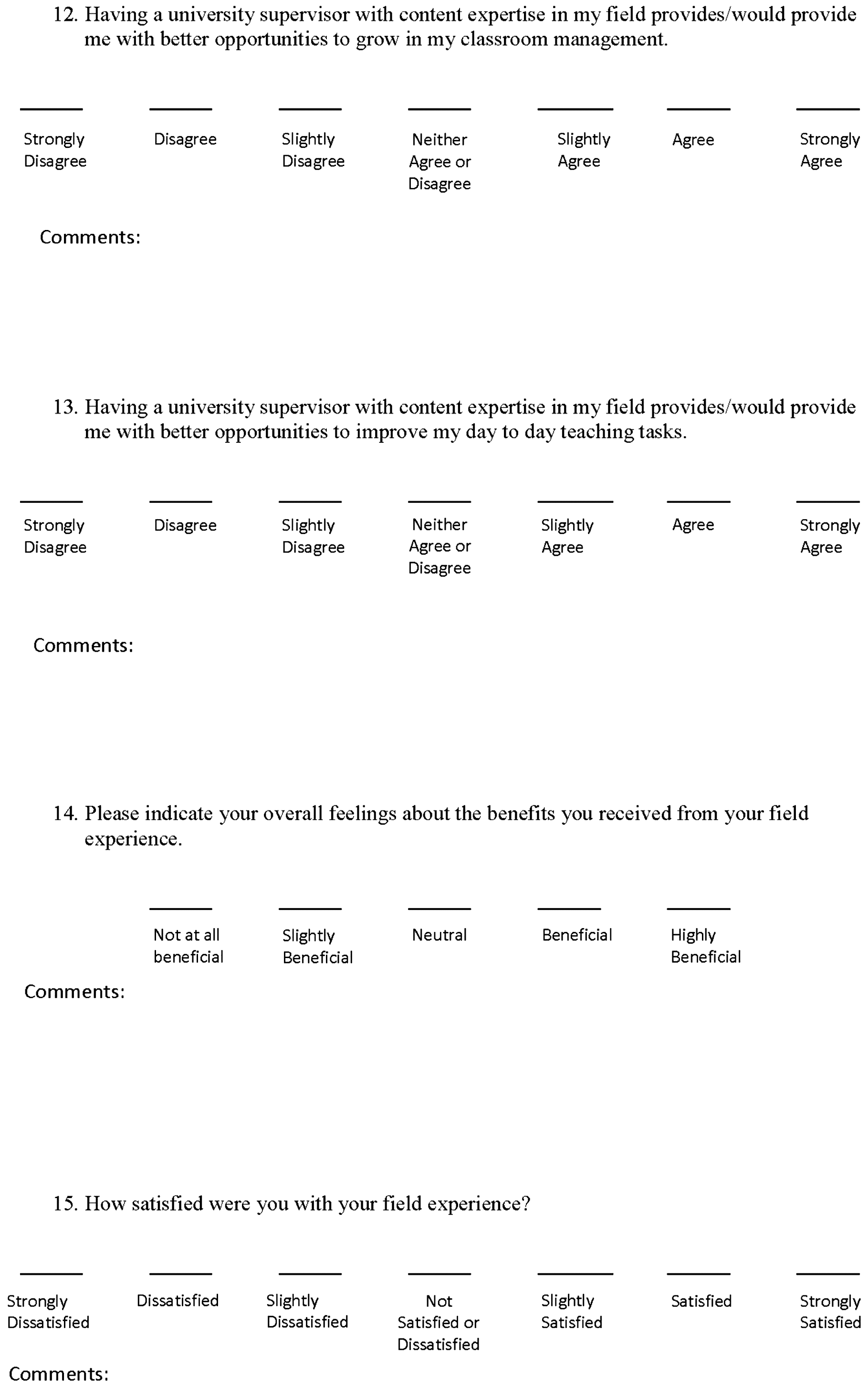Abstract
Because a majority of teachers come from public universities, universities play an important role in examining and strengthening their teacher preparation programs to ensure they are graduating quality teachers. Student teaching is typically the culminating experience of the teacher preparation program and is considered to be the most crucial and beneficial learning experience. This article presents research from a study of 205 public universities across the United States with teacher education programs on the involvement of faculty in the student teaching experience as well as a follow-up study with 28 methods students and their perceptions about their supervision experience. The findings could foster discussions in order to strengthen university teacher preparation programs.
Public Interest Statement
Faculty in teacher preparation programs provide future teachers with a foundation in human development, learning theories, and educational philosophy which can empower them to take an active role in shaping the education of children. The university supervisors share this responsibility by assisting the future teachers in the school settings. However, little is done to foster the partnership between the college faculty and the university supervisors related to course content and observations in the school settings. University supervisors should discuss what they see in the field with faculty in order to make necessary course curriculum adjustments at the university level. Communication and collaboration are key to a successful teacher preparation program in which all universities should strive to achieve.
1. Introduction
In education today, reformers are focused on reshaping America’s educational system, prompting states to think about how to better prepare students for success in the twenty-first century. Currently, much attention is focused on an overhaul of the existing mandates contained within the federal 2001 No Child Left Behind Act (U.S. Department of Education, Citation2011a). According to Maleyko and Gawlik (Citation2011), the “reform aims to hold educational agencies and states accountable for improving the quality of education for all students” (p. 600). No Child Left Behind seeks to identify and transform low-performing schools by mandating that only qualified teachers teach in public school classrooms and using state assessments to ensure that students are meeting academic standards. Another reform, the U.S. Department of Education’s (Citation2011b) Race to the Top Fund, described by Secretary Arne Duncan as a “once in a lifetime chance to change our schools,” is receiving much attention in our public schools (National Council on Teacher Quality, Citation2011; p. 1). In general, the Race to the Top Fund presents states with a unique opportunity to accelerate their efforts to graduate all high school students prepared for college, careers, and life by adopting common standards (Barnes, Citation2011). According to Barnes (Citation2011), the federal government could plan on making the receipt of Title I funding (U.S. Department of Education, Citation2011c) contingent upon the adoption of these common standards in an attempt to standardize education. Title I, Part A (Title I) of the Elementary and Secondary Education Act, established in 1965, provides financial assistance to local educational agencies and schools with high percentages of children from low-income families to help ensure that all children meet challenging state academic standards. In the school year 2009–2010, more than 21 million students were provided academic support and learning opportunities through the use of Title I funds.
With all that is transpiring in educational reform, it is important for educators to consider ways to strengthen our educational system both in the teacher preparation programs and in the public schools. Because a majority of teachers come from public universities, universities play an important role in examining and strengthening their teacher preparation programs to ensure they are graduating quality teachers (Darling-Hammond, Citation1990). According to Darling-Hammond (Citation1994), simultaneous restructuring of public schools and schools of education will require professional collaboration and collegiality in the process of redefining teaching and learning for all members of each school community. Teacher preparation programs in the United States are vast and varied in both function and structure. In many universities, colleges of education get the fewest resources, which include spending money or time and attention on preparing teachers (Darling-Hammond, Citation1990).
A review of the literature on teacher preparation revealed that in many pre-service programs, there is little communication between the academic program and the practicum (Beck & Kosnik, Citation2002). Relatively few researchers have asked questions about the involvement of faculty throughout the teacher preparation program, specifically during the student teaching experience.
The study of 205 public universities across the United States with teacher education programs addressed the questions of (a) To what extent are the tenured or tenure-track reading faculty at regional public universities directly involved with student-teachers?, (b) To what extent are the tenured or tenure-track reading faculty supervising the same students whom they taught in undergraduate reading/methods courses?, and (c) What are reading faculty’s impressions and feelings regarding the student teaching experience? A follow-up study with undergraduate methods students addressed the questions of (a) To what extent does the university supervisor’s content area specialty impact the methods experience and (b) To what extent does the university supervisor’s content area specialty impact the student teaching experience?
2. Literature review
2.1. Teacher preparation programs
During the nineteenth century, education reformers sought to establish a common school where all students were educated without regard to social class and religion. Horace Mann, an American lawyer, hoped that by bringing all children of all classes together, they could have a common learning experience (Mann, Citation1891). Mann became a recognized public figure when he was elected to the Massachusetts State legislature. In 1837, the Massachusetts School Board was formed and Mann was appointed by the governor as a board member and then quickly became the first secretary of the board to direct educational reform. For 12 years, Mann served as secretary, helping set the pattern for the developing common school. According to Borrowman (Citation1965), Mann has been credited by education historians as the father of the common school. By 1850, there were close to 81,000 public common schools in the United States (Lucas, Citation1997).
As soon as common schools were established, education reformers set out to create a program to train teachers who would work in these schools. The idea of teacher preparation in schools, called normal schools, is generally credited to Horace Mann. Mann (Citation1845) stated “in order to bring up our schools to the point of excellence demanded by the nature of our institutions, must there not be a special course of study and training to qualify teachers for their office?” (p. 65). According to Dewey (Citation1915), “the normal school arose because of the necessity for training teachers, with the idea of partly professional drill and partly that of culture” (p. 63). Normal schools claimed to produce teachers prepared for the practical matters of the common school classroom (Fraser, Citation2007). Formal teacher education in America began in the first public normal school in Lexington, Massachusetts in 1839 (Coble, Edelfelt, & Kettlewell, Citation2004). According to Coble et al. (Citation2004), the normal school was a place where prospective elementary school teachers studied the subjects they would teach (such as the Bible and orthography), learned teaching methodology, and practiced teaching in model schools for up to one year prior to accepting responsibility for a class of students. The second state normal school in the United States was established in 1839 in Barre, Massachusetts, and provided its students with the same practice teaching experience. By 1885, normal schools existed in states from Maine to California. By the end of the nineteenth century, there were 167 public normal schools and several other private ones graduating more than 11,000 students (Johnson, Citation1968).
The development of teacher preparation in colleges and universities followed the normal school movement with the establishment of laboratory schools. Laboratory schools provided prospective teachers with a setting for learning, using model classrooms as a place to practice new skills (Coble et al., Citation2004). In contrast to the popular use of laboratory schools as clinical practice facilities, education reformer Dewey asserted that research should be the primary mission of laboratory schools. The university or college is “a place of research, where investigation is going on: a place of libraries and museums, where the best resources are gathered, maintained, and organized” (Dewey, Citation1915, p. 71). According to Dewey (Citation1904), project designers build on traditions of research-based methods and a laboratory view of the practical work in teacher education that emphasize the intellectual strategies of teachers. Fostered by Dewey’s belief, modern American laboratory schools were conceived and became centers for teacher training, research, and experimentation. “Founded primarily as a facility for training teachers, laboratory schools expanded beyond early, narrow functions of observation, participation and modeling to broader concepts including observation and demonstration, research and experimentation, student teaching and dissemination of instructional and teaching procedures” (Goudie, Citation1988, p. 9).
During the 1930s, 1940s, and 1950s, the number of laboratory schools gradually declined as teacher education programs increasingly used local public schools as clinical teaching sites. At the dawn of the twenty-first century, it was estimated that fewer than 100 laboratory schools remained in operation on university campuses nationwide (McConnaha, Citation1999). Structured field experiences in public schools began to play an important role in teacher education preparation.
2.2. Teacher quality
Teacher quality research plays an important role in educational reform efforts. According to Heck (Citation2007), researchers have defined teacher quality to include teachers’ knowledge, pre-service learning, instructional content, and delivery. As noted by Moss, Glenn, and Schwab (Citation2005):
Since the publication of A Nation at Risk: The Imperative for Educational Reform (Citation1983), a document that challenged many assumptions about the effectiveness of the public schools, states have been upgrading student standards, and a number of efforts have been made to upgrade the teaching profession. (p. 178)
In 1981, the United States Secretary of Education created the National Commission on Excellence in Education (Gardner, Citation1983). The Commission was tasked with presenting a report on the quality of education in America to the American people. The object of the report was to help define the problems afflicting American education and to provide solutions. A Nation at Risk (National Commission on Excellence in Education [NCEE], Citation1983) reported that declines in educational performance reflected four important aspects in the educational process: content, expectations, time, and teaching. The content or curriculum of high schools was examined and the commission determined that the content had been diluted to the point where there was no central purpose. In addition, expectations in terms of the level of knowledge, abilities, and skills schools should possess were defined as time, hard work, behavior, self-discipline, and motivation that are essential for high student achievement. As noted by Gardner (Citation1983), evidence demonstrated
three disturbing facts about the use that American schools and students make of time: (1) compared to other nations, American students spend much less time on school work; (2) time spent in the classroom and on homework is often used ineffectively; and (3) schools are not doing enough to help students develop either the study skills required to use time well or the willingness to spend more time on school work. (p. 21)
In addition, the report raised the public’s awareness that “all children in America’s classrooms deserve nothing less than a well prepared, and caring professional who has the knowledge base and power to ensure that they reach their full potential” (Moss et al., Citation2005, p. xv).
In the twenty-first century, the discussion of teacher education has ensued relative to the essence of teacher quality; yet, there is disagreement as to what teacher quality means and how such quality relates to desirable outcomes (Cochran-Smith & Fries, Citation2005). Ingvarson and Rowe (Citation2008) suggested that the measurement of teacher quality needs to focus upon what teachers know and should be able to do. They distinguished between successful teaching, teaching which results in high-performance outcomes by students, and good teaching, which provides the learner with all the opportunities possible to enhance their competence in a particular curriculum area. Wescombe-Down (Citation2009) maintained that the mark of a quality teacher is centered on pedagogical fitness. A pedagogically fit teacher “establishes and maintains a positive, inclusive and safe learning environment” (Wescombe-Down, Citation2009, p. 20) where students’ confidence, skills, beliefs, and values can be fostered and developed. Darling-Hammond contended that, “one of the most damaging myths prevailing in American education is the notion that good teachers are born not made” (Citation2006, p. ix). Darling-Hammond also maintained that good teachers were best formed in traditional teacher preparation programs offered through institutions of higher education.
Darling-Hammond, Bransford, LePage, Hammerness, and Duffy (Citation2005) strongly believed that university-based teacher preparation programs were critical to developing teachers who were likely to be more effective in enhancing the learning and performance of the students they taught than were teachers who received little or no pedagogical training. But Darling-Hammond (Citation2006) agreed that not all teacher preparation programs were created equal. Some, she contended, are “powerful” and produced highly qualified and highly competent teachers (p. 5). Others deserved much of the criticism that had been aimed at them. Calls for the reform of teacher education often targeted the closing of the gap between university teacher preparation programs and K-12 schools (Holmes Group, Citation1986).
2.3. Student teaching
During the 1950s, the term practice teaching was replaced with student teaching and research about student teaching became more popular. Since the 1950s, student teaching has remained mostly unchanged and still closely resembles the apprenticeship model (Johnson, Citation1968). The apprenticeship concept dates back to the Middle Ages when “it was common to learn a trade by serving a lengthy apprenticeship under a ‘master’ already engaged in that line of work” (Johnson, Citation1968, p. 1). Student teaching is typically the culminating experience of the teacher preparation program and is considered to be the most crucial and beneficial learning experience (Conway, Citation2002; Johnson & Napper-Owen, Citation2011; Jor’dan, Citation2016; Savage, Cannon, & Sutters, Citation2015). Not only do many researchers view clinical practice in the field as a vital component to effective teacher preparation but also as crucial to teacher education program improvement (Darling-Hammond, Citation2014; Moulding, Stewart, & Dunmeyer, Citation2014). Savage, Cannon, and Sutters, (Citation2015) strongly advocate the importance of student teaching as “the most authentic learning opportunity teacher preparations programs offer” (p. 22). Furthermore, Guyton and McIntyre (Citation1990) maintained most teachers claimed that the most important elements in their education were the school experiences found in student teaching.
Although there are many components to teacher preparation programs, the actual student teaching experience is often seen as the “bridge between preparation for teaching and the beginning of a teaching career” (Weaver & Stanulis, Citation1996, p. 27). According to Johnson and Napper-Owen (Citation2011), it is during the student teaching experience that student-teachers refine the critical teaching skills they will need as practicing teachers, while being supervised and mentored by a cooperating teacher and university supervisor. All supervisors share the common goal of making the student teaching experience “a productive time for professional growth and orientation to the world of teaching” (p. 44).
The student teaching experience triad consists of student-teacher, cooperating teacher, and university supervisor. According to Johnson and Napper-Owen (Citation2011), “the formation of a collaborative group is essential for a successful and positive experience for the entire triad” (p. 45). Past research has focused on the student teaching experiences from the different perspectives of triad members, such as the university supervisor’s and student-teacher’s perspectives (Bain, Citation1991), the cooperating teacher’s perspective (Koerner, Citation1992), and student-teachers’ perspectives of cooperating teachers (Rikard & Knight, Citation1997). Studies also exist on the relationships between the members of the triad (Lemma, Citation1993). Additionally, studies focused on role perceptions (Bullough et al., Citation1999). The researchers found relatively little research on the university supervisor (Griffin, Citation1985; Koerner, Rust, & Baumgartner, Citation2002; Steadman & Brown, Citation2011). Is it important that the university supervisor have a similar content area specialty that reflects the teacher candidate’s content area? In a recent study (Darling-Hammond, Citation2014), researchers examined teacher education preparation programs and one of the critical components in the most effective programs included methodically selected student teaching placements that corresponded to the student-teacher’s content area. In addition to pairing the teacher candidates with mentors with well-matched content areas, according to the National Council on Teacher Quality Student Teaching Standards (Greenberg, Pomerance, & Walsh, Citation2011), mentor teachers should also meet the following qualifications including having three years of experience, possess the capacity to have a positive impact on learning, and are able to mentor adults.
Cooperating/mentor teachers are generally defined as classroom teachers who participate in the teacher education program by agreeing to work with student-teachers in their classrooms. Because the cooperating teacher observes and interacts with the student-teacher on a daily basis during the experience, there is no doubt as to the influence the cooperating teacher has on the student-teacher (Johnson & Napper-Owen, Citation2011). A number of studies of the relationship between cooperating teachers and student-teachers were designed from the teacher’s perspective (Copas, Citation1984; Rikard & Veal, Citation1996). According to Copas (Citation1984), student-teachers rated cooperating teachers’ influence high in the areas of role development, professional skills, and personal support. Additional findings emphasized the importance of communication as a means of exploring the ways in which student-teachers think about teaching.
In their study, Savage et al. (Citation2015) found common themes after surveying teacher candidates regarding their student teaching and what they felt they needed from their mentor teacher in order to be more successful including providing constructive feedback on lessons, motivating students, earning respect from students, differentiating instruction, assessment strategies, and parent communication.
An equally complex role in the triad is played by the university supervisor. According to Steadman and Brown (Citation2011), the university supervisor “oversees student teachers’ work and represents the university during teacher candidates’ internships in the K-12 schools” (p. 51). According to Griffin (Citation1985), the supervisor is the participant who receives the least recognition and has been the least studied. Yet, research suggested that the supervisor played a critical role in the success of the student teaching experience (Koerner et al., Citation2002). Asplint and Marks (Citation2013) found that when student-teachers have a positive relationship with their supervisors, they are more likely to heed their supervisors’ advice as well as view them as more knowledgeable in the classroom.
The first two editions of Handbooks of Research on Teacher Education (Houston, Haberman, & Sikula, Citation1990; Sikula, Buttery, & Guyton, Citation1996) contained 2,040 pages addressing research. Only seven of those pages were devoted to research regarding the members of the student teaching triad, and of those seven pages, just two-and-one-half were allotted specifically to university supervisors and their relationships to their university and to the triad. Moreover, the variety and range of their practices were not examined. The mentor teachers who supervised the work of the student-teachers in their classrooms typically knew very little about what took place in the university classes; the university instructors typically knew very little about what went on in the student-teachers’ classrooms (Guyton & McIntyre, Citation1990).
3. Methodology
Descriptive studies have an important role in educational research (Gall, Borg, & Gall, Citation2002). The methods of collecting data for descriptive research can be employed singly or in various combinations, depending on the research questions at hand. The research design in this study is what Johnson and Christensen (Citation2012) refer to as a mixed model research design. The primary method is quantitative in nature and the secondary aspect is qualitative. The questionnaires used in this study contained both open and closed response questions. These methods made a descriptive design appropriate for examining the involvement of faculty in field experiences. This study was reviewed and approved by the university’s Institutional Review Board.
4. Instrumentation
The researchers designed the first questionnaire, the University Structure Questionnaire (USQ), which would be sent to student teaching directors. The USQ consisted of 18 questions. Seventeen closed questions reported the demographics of the university, the structure of the student teaching function, the involvement of faculty and staff as student teaching supervisors, and the degree of their involvement. The final open-ended response question asked for the names and emails of two tenured or tenure-track reading faculty at the institution who taught undergraduate reading education classes whom the researcher could contact to participate in an additional survey. The complete questionnaire is in Appendix A.
Validity of the USQ was developed through a series of steps. The guiding purpose of the researcher-developed questions was to provide information to determine the structure of the university undergraduate elementary education program and identify reading faculty at each institution. Upon completion of an initial questionnaire, the researchers sent the instrument to colleagues for feedback. Based upon the feedback, the questions were revised. The questionnaire was then sent to one former and one current Director of Student Teaching at two non-participating universities to check the validity and clarity of the questions. Based upon the feedback received from these directors, new questions were added and existing questions were revised.
The researcher-designed questionnaire, Reading Faculty Involvement Questionnaire (RFIQ), was created to determine the involvement of reading faculty in the student teaching experience. Seventeen closed questions asked for information on the demographics of the reading faculty, course load specifics, specific involvement in the student teaching experience, and the structure of the student teaching experience. One question near the end of the questionnaire asked respondents to leave their name, phone number, and email address if they were willing to participate in a follow-up survey. The final open-ended response question asked respondents to list any other comments on student teaching. The complete questionnaire is in Appendix B.
Validity of the RFIQ was established through a series of steps and procedures similar to those used in developing the USQ. The researchers sent the questionnaire to colleagues for feedback. The instrument was edited and given to three current reading faculty members at non-participating institutions to check the validity and clarity of the questions. Comments were reviewed and necessary adjustments were made to the instrument. The revised RFIQ was emailed to reading faculty at institutions who provided data from the USQ.
The researcher-designed questionnaire, the Field Experience Questionnaire (FEQ), was created to determine the perceptions of teacher candidates in the field experience process as it related to their university supervisor. Fifteen questions asked for demographics of the teacher candidates along with specific questions regarding their interactions with their university supervisor and their feelings about their experience. The complete questionnaire is in Appendix C.
Validity of the FEQ was established through a series of steps and procedures similar to those used in developing the others. The researchers sent the questionnaire to colleagues for feedback. The instrument was edited and given to five teacher candidates at non-participating institutions to check the validity and clarity of the questions. Comments were reviewed and necessary adjustments were made to the instrument.
5. Participants
The Secretary of the U.S. Department of Education recognizes six regional agencies as reliable authorities to award full accreditation to educational institutions who meet the standards that address the quality of their programs. The six regional accrediting agencies for post-secondary educational institutions were used to locate universities who could confer an undergraduate elementary teaching degree.
In order to target the intended population of regional universities, the Carnegie Classification System was used and any school that did not have the medium size, four-year degree (M4) designation was removed. As a result of the verification steps, 205 institutions were eligible to participate in the study. One hundred participants completed the USQ, representing a participation rate of 48.8%. Through the data of their answers, the names of 142 reading faculty were submitted for participation in the RFIQ. The researchers sent an email to each of the 142 reading faculty. Of the 142 faculty who were invited to complete the RFIQ, 74 completed the questionnaire. This amount represented a participation rate of 52.1%.
For the second phase of the study, the participants were 28 undergraduate teacher candidates enrolled in a required educational course at a large university in the southern United States. This amount represented a participation rate of 100%. Most students were in their final semester of courses and were surveyed after they completed their field experience.
6. Data analysis
Data were collected over a 12-month period for the initial survey and over two semesters for the second phase of the study. The USQ provided quantitative data. The RFIQ and FEQ provided additional quantitative data and qualitative data from open-ended narrative responses. Because the nature of open-ended responses is broad, it was necessary to develop a system by which the responses could be analyzed effectively. The reliance on coding and categorizing of data makes the technique of content analysis particularly rich and meaningful (Krippendorff, Citation2004). Data analysis of the narrative responses in this study followed an emergent coding design. Participants were asked in the RFIQ to list any other comments on student teaching. The researcher was interested to find out: If given the opportunity to say anything in relation to student teaching, would there be common themes?
The emergent coding process used followed a series of steps recommended by Johnson and Christensen (Citation2012). First, all narrative responses were read by the primary researcher and key terms were highlighted. Next, the primary researcher read each narrative response a second time and wrote down a theme for every response. After this review, nine categories existed. Upon reexamination of the categories, the researcher decided that the nine categories could be combined.
Next, the primary researcher asked the secondary researcher to review the responses and category development. The researcher was supplied with the narrative responses and the six categories. Initially, there was an agreement between the researchers as follows: Category 1 = 60%, Category 2 = 85%, Category 3 = 90%, Category 4 = 100%, Category 5 = 92%, and Category 6 = 73%. A follow-up conversation took place and after additional examination and discussion, the researchers yielded a consensus (96%) on coding the narrative responses.
7. Findings
The RFIQ was completed by 74 reading faculty from regional public universities who responded to the USQ. The FEQ was completed by 28 undergraduate middle-level education teacher candidates from a large state university.
7.1. Demographic profiles
The majority (85.2%) of the study’s respondents to the RFIQ were either tenured faculty members (64.9%) or tenure-track faculty members (20.3%), which were the intended target audience for this study. Seventy percent of respondents were ranked as either associate professor (36.5%) or assistant professor (33.8%).
The majority of the study’s respondents (87.8%) taught undergraduate reading courses, which was the intended target audience for this study. More than half (58.1%) taught two or more undergraduate reading education courses each semester.
The undergraduate teacher candidates included 24 females (86%) and 4 males (14%). All were middle-level education majors. The ethnicity of these teacher candidates numbered: 18 European Americans (64%), 6 African-Americans (21%), and 4 Hispanics (14%). Their age ranged from 21 to 46 with a mean age of 22.8.
7.2. Information on the involvement of reading faculty in the supervision of student teaching
Table presents information from the RFIQ on the involvement of the reading faculty respondents in the supervision of student teaching within the past three years.
Table 1. Supervision of student teaching
Almost half of the respondents (47.3%) reported that they have not been a supervisor of student-teachers within the past three years. Those respondents who reported that they have not been a supervisor in the past three years were asked in a follow-up question to explain/elaborate their answer. Fourteen out of the 35 respondents elaborated on their answer. One-third (35.7%) reported that they could not supervise student-teachers due to their full course load. Three study respondents reported that faculty do not supervise student-teachers and one stated that “tenure and tenure-track faculty have not been encouraged to take student teachers.” Fourteen percent reported that the supervision of student-teachers is in a different department. Almost half (45.9%) of respondents have frequently or occasionally supervised student-teachers that they taught in an undergraduate reading course. One of the respondents who reported that they have not supervised student-teachers they taught in undergraduate reading education courses stated “I intend to make student teaching part of my load soon but I think this will result in me not getting tenure but I’ve reached a point where I don’t care.”
7.3. Information on the personal involvement of reading faculty
Table reports information from the RFIQ on the level of involvement of the reading faculty. Data include topics such as frequency of contacts about classroom reading practices, classroom visits, and contacts of former students who are student teaching.
Table 2. Level of involvement
Over one-third of respondents (37.9%) reported that they are frequently or occasionally contacted about classroom reading practices from student-teachers, cooperating teachers, and/or supervisors. The majority (60%) of those who reported that they occasionally were contacted, and who answered a follow-up question, stated that they were contacted to suggest reading practices/resources. Thirty percent reported that they were occasionally contacted about specific practices/resources that the respondents taught the students in a previous course. The majority of respondents (56.7%) reported that they frequently or occasionally visit classrooms that have student-teachers. Of those who answered a follow-up question, 62% reported that they visited classrooms as a supervisor of student-teachers. Almost half (44.6%) of respondents reported that they frequently or occasionally contact former students who are student teaching and offer assistance and/or support. Half (50%) of the respondents who reported that they occasionally contacted former students and all (100%) who reported that they frequently contacted former students, and who answered a follow-up question, actually stated that they were contacted by former students instead of contacting students themselves.
7.4. Information on the supervision of student-teachers
Table reports information from the RFIQ on the supervision of student-teachers. Data are reported from topics such as who supervise student-teachers and how often those supervisors meet with reading faculty to discuss issues they see in the field.
Table 3. Student teaching supervision
The majority (62.2%) of study respondents reported that there are one or more reading faculty members who supervise student-teachers. A large percentage (41.9%) of respondents reported that mostly tenure-track faculty supervised student-teachers. An almost equal number (40.5%) of respondents indicated that mostly graduate assistants or adjunct faculty supervise student-teachers. Thirteen study respondents who reported that mostly graduate assistants or adjunct faculty supervised student-teachers answered a follow-up question to explain/elaborate their answer. More than half (53.8%) of those indicated that tenured or tenure-track faculty do not supervise due to their full course load. Two of the 13 stated their supervision decision was due to budget reasons. Almost half (44.6%) reported that supervisors of student-teachers do not meet with reading faculty to discuss what they see in the field. One-fourth (25%) of respondents who answered the follow-up question to elaborate/explain why reading faculty do not meet with supervisors to discuss what they see in the field stated that they would like this practice to occur. One of those respondents reported “I am hopeful that our department will soon provide an opportunity for these supervisors to share what they are seeing/experiencing in the field with our students.” Another stated “I think it’s because no one has ever thought of doing that. But making time to do this would be important, and to be honest, I have not thought of this.”
7.5. Information on the schedule of reading courses
Table reports information from the RFIQ on the structure of undergraduate reading education courses. This structure includes topics such as how many tenure-track faculty members teach reading education courses, how many undergraduate reading education courses are taken before student teaching, and information if a reading course is taken concurrent with student teaching.
Table 4. Undergraduate reading education courses: structure
Three-fourths (76.7%) of respondents have four or fewer tenure-track faculty members teach reading education courses at their institution. Half (50%) reported that three or more undergraduate reading education courses are taken before student teaching in their program. Thirty respondents indicated that two undergraduate reading education courses are taken before student teaching. Five percent (5.4%) of respondents reported that one or more undergraduate reading education courses is taken concurrent with student teaching. Of the four who responded that the courses are taken concurrent with student teaching, two institutions have the course embedded into student teaching and two offer them as a separate and distinct reading class.
7.6. Comments on student teaching
Table presents responses from the open-ended question in the RFIQ asking respondents to list any other comments on student teaching.
Table 5. Response text: Comments on student teaching
Comments stating elaboration or explanations of respondents’ answer choices to include general thoughts about their involvement in relation to the focus of this survey represented 42% of the comments. One respondent reported that it is frowned upon for tenure-track faculty to supervise student-teachers and stated, “I do add practicum’s to the courses I teach so that way I have some idea of what the teacher candidates are like as teachers.” Another 15 responses reflected elaboration or explanations of respondents’ answer choices to include general thoughts about their school’s/program’s framework in relation to the focus of this survey. One respondent stated “At our institution, we have heavily field-based preparation PRIOR to student teaching and we do have a lot of reading education classes dealt with that way. It’s just that by the time it gets to student teaching, they are more on their own.” Another stated “Our apprentices/student teachers all complete their experiences in partner schools with master teachers that have been approved by our university.” Three comments were positive related to the survey topic such as “This line of inquiry that you are taking on is very important” and “I like the direction of your survey.
7.7. Information on placement of teacher candidates
Table represents responses from students on the FEQ regarding their field placement experiences as it related to their field supervisor.
Table 6. Field experience questionnaire: Field experience
Within their field experience placement, 18 out of 28 students (64%) were placed with a university supervisor outside of their content area. The remaining 10 students (36%) were supervised by a university supervisor from the same content area specialty. Of the 36% placed with a university supervisor, 100% expressed they were strongly satisfied with their field experience. Eight out of 10 (80%) strongly agreed that a different supervisor would have negatively impacted their field experience. Ten out of 10 (100%) strongly agreed that having a university supervisor with content expertise in the student’s field provided them better opportunities to grow in their content area as well as classroom management and day-to-day teaching tasks. Overall, the students rated their field experience as highly beneficial (100%). Those placed with supervisors outside their content reported less satisfaction with their experience. Of those students, 10 out of 18 (56%) expressed they were strongly satisfied with their field experience, while 6 out of 18 (33%) expressed they were simply satisfied with their field experience. The remaining 2 out of 18 (11%) expressed they were indifferent about their field experience. Seventeen out of 18 (94%) agreed that a different supervisor would have positively impacted their field experience. Overall, 4 out of 18 (22%) reported their field experience as highly beneficial, 3 out of 18 (17%) described their field experience as beneficial, and 11 out of 18 (61%) reported that their field experience was not as beneficial as they had hoped.
8. Discussion
8.1. Student teaching experience
The RFIQ, which was completed by reading faculty, also addressed the research question “To what extent are regional public universities using tenured or tenure-track education faculty who teach undergraduate methods courses as supervisors during student teaching?” Results indicated that 41.9% of the respondents reported that mostly tenure-track faculty supervised student-teachers. An almost equal number of respondents (40.5%) indicated that graduate assistants or adjunct faculty supervised student-teachers.
In responses to the follow-up questions, more than half of the RFIQ respondents indicated that tenured or tenure-track faculty did not supervise due to full course loads. Two of the 13 respondents stated their supervision decision was due to budget reasons. Based upon the data acquired in this study, what is unknown is whether budget reasons were the determining factor in not using tenure-track faculty to supervise student-teachers for the remainder of the 13 respondents, or if a decision had been made to utilize faculty as course instructors for other reasons, such as Beck and Kosnik’s (Citation2002) assertion that faculty members are used for other scholarly duties.
When the data from the surveys and the reading faculty member’s responses are considered as a whole, the results indicate that non-tenure-track faculty (i.e. adjuncts and doctoral students) are more likely to be used to supervise student-teachers than tenure-track faculty members; yet, students prefer the content area expertise and pedagogical knowledge that comes from a tenure-track faculty member.
Beck and Kosnik (Citation2002) posited that there are several reasons for the limited number of faculty supervisors supervising student-teachers. These included their commitments to graduate teaching, research, publishing, administration, and committee work. The data gathered in this study neither support nor disagree with Beck and Kosnik’s assertions about use of doctoral students and adjuncts in supervising student-teachers or faculty commitments to scholarship. This study’s findings indicate some use of tenured and tenure-track faculty in supervising student-teachers. However, this finding could have been the results of the medium-sized colleges and universities surveyed in this study. Beck and Kosnik’s assertions about use of doctoral students and adjuncts could be valid at larger doctoral granting institutions.
8.2. Involvement of reading faculty in student teaching experience
Reading faculty involvement in the student teaching experience was presented in the data from the RFIQ. The majority of the respondents were tenured assistant or associate professors who taught undergraduate reading courses, yet had not supervised student-teachers in the past three years. Student responses to field experience were presented in the data from the FEQ. The majority of respondents not supervised by content area specialists were less satisfied with their field experience than those supervised by someone with a similar content background.
Data from the RFIQ addressed the research question “To what extent are the tenured or tenure-track reading faculty members supervising the same students whom they taught in undergraduate reading/methods courses?” Almost half (45.9%) of respondents have frequently or occasionally supervised student-teachers that they taught in an undergraduate reading course. Descriptive data from a follow-up question in the RFIQ addressed the research question “What are reading faculty members’ impressions and feelings regarding the student teaching experience?” One of the respondents who reported that they have not supervised student-teachers they taught in undergraduate reading education courses stated “I intend to make student teaching part of my load soon but I think this will result in me not getting tenure but I’ve reached a point where I don’t care.”
The Torch Lighters (Austin & Morrison, Citation1961) reported that instructors had no way of knowing how well they were preparing students to teach reading because they did not have the opportunity to observe their students during the student teaching experience. The RFIQ data addressed the research question “To what extent are the tenured or tenure-track reading faculty members at regional public universities directly involved with student teachers?” Results indicated that 56% of respondents frequently or occasionally visited classrooms with student-teachers. The interpretation could be made that reading faculty valued the importance of classroom observations in order to make necessary adjustments to their teaching and frequently or occasionally took the time to make classroom visits. Teacher candidates certainly value their expertise as indicated from the FEQ data. An unexpected finding resulted when respondents were asked to elaborate on why they visited classrooms. Sixty-two percent of those who frequently or occasionally visited classrooms responded that they did so in the role of supervisor. The researchers are interested in discovering if the reason reading faculty visited classrooms was because they valued the importance of a visit rather than because they were required to visit classrooms in the role of supervisor. This is an area for further investigation.
The Teacher Education Accreditation Council’s goal is to support the preparation of competent, caring, and qualified professional educators (Teacher Education Accreditation Council [TEAC], Citation2011). One of TEAC’s quality principles states that there must be a system of inquiry, review, and quality control in place through which the faculty could secure the evidence and informed opinion needed to improve program quality. The RFIQ data addressed the research question “To what extent are the tenured or tenure-track reading faculty members at regional public universities directly involved with student teachers?” Results indicated that it was not a common practice for student-teacher supervisors to meet with reading faculty to discuss what they see in the field. Almost half (44.6%) of the supervisors in this survey reported they did not meet at all with reading faculty. This is consistent with research that has shown there is generally a large disconnect between the curriculum of teacher education programs on the university campus and the student-teachers’ work in schools (Beck & Kosnik, Citation2002; Guyton & McIntyre, Citation1990). University instructors typically know very little about what goes on in the student-teachers’ classrooms (Guyton & McIntyre, Citation1990).
The narrative responses in this study support the assumption that having supervisors meet with reading faculty would be beneficial as is also indicated by teacher candidate data in the FEQ. Descriptive data from a follow-up question in the RFIQ addressed the research question “What are reading faculty members’ impressions and feelings regarding the student teaching experience?” One of those respondents reported “I am hopeful that our department will soon provide an opportunity for these supervisors to share what they are seeing/experiencing in the field with our students.” Another stated “I think it’s because no one has ever thought of doing that. But making time to do this would be important, and to be honest, I have not thought of this.”
The National Council for Accreditation of Teacher Education’s goal is to help ensure that teachers are competent and qualified through a voluntary review process of accreditation. According to NCATE (Citation2008), the partners share resources and expertise to create roles and structures that support and create opportunities for candidates to learn. The RFIQ data addressed the research question “To what extent are the tenured or tenure-track reading faculty members at regional public universities directly involved with student teachers?” Data indicated that over one-third of respondents (37.9%) were frequently or occasionally contacted about classroom reading practices from student-teachers, cooperating teachers, and/or supervisors. Almost half of the respondents (44.6%) reported that they frequently or occasionally contacted former students who were student teaching and offered assistance and/or support. Sailors, Keehn, Martinez, & Harmon, (Citation2005) reported that beginning teachers valued the scaffolding by knowledgeable others such as university instructors and cooperating teachers.
9. Implications of the study
The findings from this study indicated that tenured and tenure-track faculty are not frequently used as student teaching supervisors. Because of their expertise, knowledge, and experiences, tenured and tenure-track faculty should be considered especially if they have a personal interest in supervision. Teacher candidates express a desire to have their expertise as they progress through their field experience. The results from this study indicated that the majority of respondents had not changed their decision on who will supervise student-teachers in the past two years. Directors of student teaching should consider a frequent examination of who is used as a supervisor and if those decisions are aligned with the goals of the student teaching experience.
The findings from this study are important because they provided research on the involvement of university faculty in the student teaching experience. Universities should consider involving faculty in the planning and frequent review of the student teaching experience and other field experience courses. The examination of all field experiences could be guided by the following questions: Who will supervise/lead the pre-service teachers?, What training will the supervisors/leaders receive?, How often will training occur?, Will the supervisors/leaders meet with faculty to discuss any changes to the experiences?, and Are the classroom teachers that the pre-service teachers are assigned to work with identified by university faculty as exemplary teachers?
The seminal study entitled The Torch Lighters (Austin & Morrison, Citation1961) provided recommendations for improving reading preparation programs. The Torch Lighters Revisited (Morrison & Austin, Citation1977), published 16 years after the original Torch Lighters, was a follow-up study to determine if any of the original recommendations were used by schools to improve their teacher preparation programs. The current study provided research on the involvement of reading faculty in the student teaching experience and the findings can guide university discussions to strengthen reading preparation programs.
Using the findings from this study, universities can increase the involvement of reading faculty in the student teaching experience. Reading faculty should consider meeting with student teaching supervisors to discuss what they see in the field in order to make necessary course curriculum adjustments. In addition, reading faculty should consider providing training to supervisors on best practices in reading to help them provide the necessary support to the student-teachers. Reading faculty should consider visiting classrooms with student-teachers and also contacting former students who are student teaching to offer assistance and/or support.
10. Summary of the study
With all that is transpiring in educational reform, such as reauthorization of No Child Left Behind and Race to the Top, it is important for educators to consider ways to strengthen the educational system via teacher preparation programs. Calls for the reform of teacher education often target closing of the gap between university teacher preparation programs and K-12 schools (Holmes Group, Citation1986).
This study focused on the involvement of faculty in the student teaching component of teacher preparation programs. It is an assumption that these findings will appeal to universities seeking to enhance the professional relationship between the student teaching experience and faculty. University faculty should use the findings in this study to increase their involvement in the student teaching experience. Communication and collaboration are key to a successful teacher preparation program which all universities should strive to achieve.
Additional information
Funding
Notes on contributors
Jalene P. Potter
Jalene P. Potter, PhD, is an assistant professor at Sam Houston State University. Her research interests include curriculum alignment, curriculum development, and both pre-service and in-service teacher preparation.
Tori Hollas
Tori Hollas, PhD, is an assistant professor at Sam Houston State University in Hunstville, Texas. Her research interests include curriculum studies, teacher induction, and both pre-service and in-service teacher preparation.
Jaime Coyne
Jaime Coyne, PhD, is an assistant professor at Sam Houston State University. Her research interests include teacher education and content area literacy.
References
- Asplin, K. N., & Marks, M. J. (2013). Increasing the influence of university supervisors during student teaching. The Professional Educator, 37, 1–10.
- Austin, M. C., & Morrison, C. (1961). The torch lighters: Tomorrow’s teachers of reading. Cambridge, MA: Harvard University Graduate School of Education.
- Bain, C. (1991). Student teaching triads: Perceptions of participant roles. Paper presented at the annual meeting of the Northern Rocky Mountain Educational Association, North Dakota. Retrieved from ERIC database. (ED338620)
- Barnes, C. R. (2011). Race to the top only benefits big government. Journal of Law & Education, 40, 393–402.
- Beck, C., & Kosnik, C. (2002). Professors and the practicum: Involvement of university faculty in preservice practicum supervision. Journal of Teacher Education, 53, 6–19.10.1177/0022487102053001002
- Borrowman, M. L. (1965). Teacher education in America: A documentary history. New York, NY: Teachers College Press.
- Bullough, R. V., Birrell, J. R., Young, J., Clark, D. C., Erickson, L., & Earle, R. S. (1999). Paradise unrealized: Teacher educators and the costs and benefits of school/university partnerships. Journal of Teacher Education, 50, 381–390.10.1177/002248719905000511
- Coble, C. R., Edelfelt, R., & Kettlewell, J. (2004). Who’s in charge here? The changing landscape of teacher preparation in America. Retrieved from http://www.ecs.org/clearinghouse/54/36/5436.htm
- Cochran-Smith, M., & Fries, M. (2005). Researching teacher education in changing times. In M. Cochran-Smith, K. M. Zeichner (Eds.), Studying teacher education, the report of the AERA panel on research and teacher education (pp. 69–109). Washington, DC: American Educational Research Association and Lawrence Erlbaum Associates.
- Conway, C. M. (2002). Perceptions of beginning teachers, their mentors, and administrators regarding preservice music teacher preparation. Journal of Research in Music Education, 50, 20–36.10.2307/3345690
- Copas, E. (1984). Critical requirements for cooperating teachers. Journal of Teacher Education, 35, 49–54.10.1177/002248718403500611
- Darling-Hammond, L. (1990). Teachers and teaching: Signs of a changing profession. In W. R. Houston (Ed.), Handbook of research on teacher education: A project of the Association of Teacher Educators (pp. 267–290). New York, NY: Macmillan Publishing Company.
- Darling-Hammond, L. (1994). Reforming teacher preparation and licensing: Debating the evidence. Teachers College Record, 102, 28–56.
- Darling-Hammond, L. (2006). Constructing 21st-century teacher education. Journal of Teacher Education, 57, 300–314.10.1177/0022487105285962
- Darling-Hammond, L. (2014). Strengthening clinical preparations: The holy grail of teacher education. Peabody Jouranl of Education, 89, 547–561.10.1080/0161956X.2014.939009
- Darling-Hammond, L., Bransford, J., LePage, P., Hammerness, K., & Duffy, H. (Eds.). (2005). Preparing teachers for a changing world: What teachers should learn and be able to do. San Francisco, CA: Jossey-Bass.
- Dewey, J. (1904). The relation of theory to practice in education. In C. McMurry (Ed.), The third NSSE yearbook (pp. 9–30). Chicago, IL: University of Chicago Press.
- Dewey, J. (1915). The school and society. Chicago, IL: University of Chicago Press.
- Fraser, J. W. (2007). Preparing America’s teachers: A history. New York, NY: Teachers College Press.
- Gall, M. D., Borg, W. R., & Gall, J. P. (2002). Educational research: An introduction. White Plains, NY: Pearson/Allyn & Bacon.
- Gardner, D. (1983). A nation at risk: The imperative for educational reform. An open letter to the American people. A report to the nation and the Secretary of Education. Retrieved from ERIC database. (ED226006).
- Goudie, J. W. (1988). The rise and demise of laboratory schools using Western Michigan University’s campus school as a case study. Dissertation Abstracts International, 49, 2182. ( UMI No. 8821861).
- Greenberg, T., Pomerance, L., & Walsh, K. (2011). Student teaching in the U.S. National Council on Teacher Quality. Retrieved from: http://www.nctq.org/dmsView/Student_Teaching_United_States_NCTQ_Report
- Griffin, G. A. (1985). Teacher induction: Research issues. Journal of Teacher Education, 36, 42–46.10.1177/002248718503600110
- Guyton, E., & McIntyre, J. (1990). Student teaching and school experiences. In W. R. Houston (Ed.), Handbook of research on teacher education (pp. 514–534). New York, NY: Macmillan.
- Heck, R. H. (2007). Examining the relationship between teacher quality as an organizational property of schools and students' achievement and growth rates. Educational Administration Quarterly, 43, 399–432.10.1177/0013161X07306452
- Holmes Group. (1986). Tomorrow’s teachers. East Lansing, MI: Author.
- Houston, W. R., Haberman, M., & Sikula, J. (1990). Handbook of research on teacher education. New York, NY: Macmillan.
- Ingvarson, L., & Rowe, K. (2008). Conceptualizing and evaluating teacher quality: Substantive and methodological issues. Australian Journal of Education, 52, 5–35.
- Johnson, J. A. (1968). A brief history of student teaching. DeKalb, IL: Creative Educational Materials.
- Johnson, B., & Christensen, L. (2012). Educational research: Quantitative, qualitative, and mixed approaches (4th ed.). Thousand Oaks, CA: Sage Publications.
- Johnson, I. L., & Napper-Owen, G. (2011). The importance of role perceptions in the student teaching triad. Physical Educator, 68, 44–56.
- Jor’dan, J. R. (2016). Strengthen student teaching. Principal, 95, 26–29.
- Koerner, M. E. (1992). The cooperating teacher: An ambivalent participant in student teaching. Journal of Teacher Education, 43, 46–56.10.1177/002248719204300107
- Koerner, M. E., Rust, F., & Baumgartner, F. (2002). Exploring roles in student teaching placements. Teacher Education Quarterly, 29, 35–58.
- Krippendorff, K. (2004). Content analysis: An introduction to its methodology. Thousand Oaks, CA: Sage Publications.
- Lemma, P. (1993). The cooperating teacher as supervisor: A case study. Journal of Curriculum and Supervision, 8, 329–342.
- Lucas, C. J. (1997). Teacher education in America: Reform agendas for the twenty-first century. New York, NY: St. Martin’s Press.
- Maleyko, G., & Gawlik, M. A. (2011). No Child left behind: What we know and what we need to know. Education, 131, 600–624.
- Mann, H. (1845). Lectures on education. Boston, MA: W. B. Fowle and N. Capen Publishers.
- Mann, M. (1891). Life and works of Horace Mann (Vol. 5). Boston, MA: Lee and Shepard Publishers.
- McConnaha, W. (1999). Laboratory schools in the year 2000. Retrieved from the National Association of Laboratory Schools website: http://www.nals.net/publications/lab_schools_2009.htm
- Morrison, C., & Austin, M. C. (1977). The torch lighters revisited. Newark, DE: International Reading Association.
- Moss, D. M., Glenn, W. J., & Schwab, R. L. (Eds.). (2005). Portrait of a profession: Teaching and teachers in the 21st century. Westport, CT: Praeger.
- Moulding, L. R., Stewart, P. W., & Dunmeyer, M. (2014). Pre-service teachers’ sense of efficacy: Relationship to academic ability, student teaching placement characteristics, and mentor support. Teaching and Teacher Education, 41, 60–66.10.1016/j.tate.2014.03.007
- National Commission on Excellence in Education [NCEE]. (1983). A nation at risk: The imperative for educational reform. Retrieved from http://www2.ed.gov/pubs/NatAtRisk/index.html
- National Council for Accreditation of Teacher Education [NCATE]. (2008). Professional standards for the accreditation of teacher preparation institutions. Retrieved from http://www.ncate.org/Portals/0/documents/Standards/NCATE%20Standards%202008.pdf
- National Council on Teacher Quality. (2011). A race to the top scorecard: How the “great teachers and leaders” assurance area can help states maximize their odds of winning a “race to the top” grant. Retrieved from ERIC database. (ED512684).
- Rikard, G. L., & Knight, S. M. (1997). Obstacles to professional development: Interns’ desire to fit in, get along, and be real teachers. Journal of Teaching in Physical Education, 16, 440–453.10.1123/jtpe.16.4.440
- Rikard, G. L., & Veal, M. (1996). Cooperating teachers: Insight into their preparation, beliefs, and practices. Journal of Teaching in Physical Education, 15, 279–296.10.1123/jtpe.15.3.279
- Sailors, M., Keehn, S., Martinez, M., & Harmon, J. (2005). Early field experiences offered to and valued by preservice teachers at sites of excellence in reading teacher education programs. Teacher Education and Practice, 18, 458–470.
- Savage, S. L., Cannon, D., & Sutters, J. P. (2015). The yellow brick road: Mentoring student teachers. Art Education, 68, 22–27.
- Sikula, J., Buttery, T. J., & Guyton, E. (Eds.). (1996). Handbook of research on teacher education. New York, NY: Macmillan.
- Steadman, S. C., & Brown, S. D. (2011). Defining the job of university supervisor: A department-wide study of university supervisors’ practices. Issues in Teacher Education, 20, 51–68.
- Teacher Education Accreditation Council [TEAC]. (2011). TEAC principals and standards for teacher education programs. Retrieved from http://www.teac.org/
- U.S. Department of Education. (2011a). Elementary and secondary education act [No Child Left Behind]. Retrieved from http://www.ed.gov/esea
- U.S. Department of Education. (2011b). Race to the top fund. Retrieved from http://www2.ed.gov/programs/racetothetop/index.html
- U.S. Department of Education. (2011c). Improving basic programs operated by a local educational agencies (Title I, Part A). Retrieved from http://www2.ed.gov/programs/titleiparta/index.html
- Weaver, D., & Stanulis, R. N. (1996). Negotiating preparation and practice: Student teaching in the middle. Journal of Teacher Education, 47, 27–36.10.1177/0022487196047001006
- Wescombe-Down, D. (2009). Pedagogical fitness, teacher quality. Professional Educator, 8, 18–21.
Appendix A
University structure questionnaire
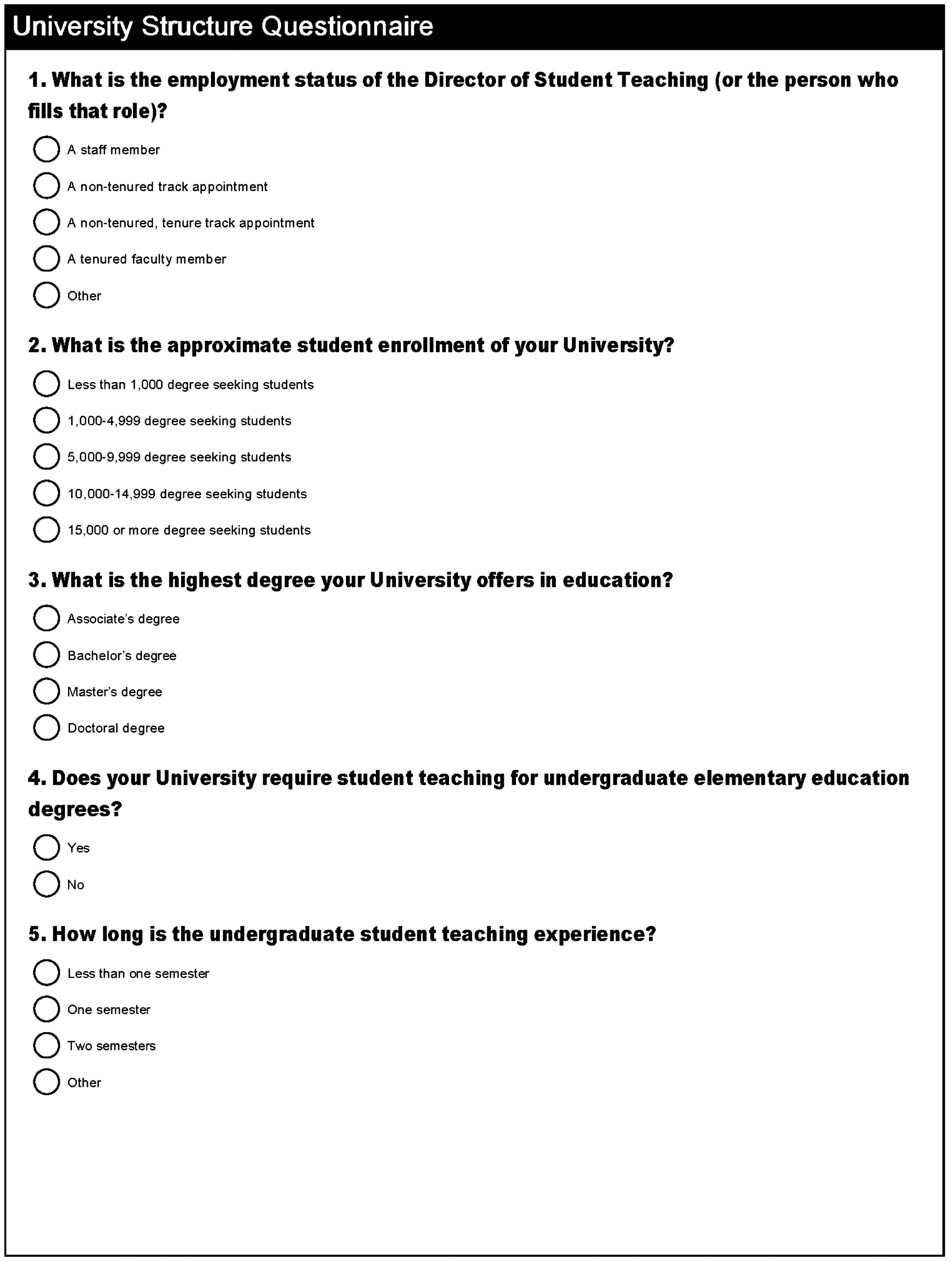
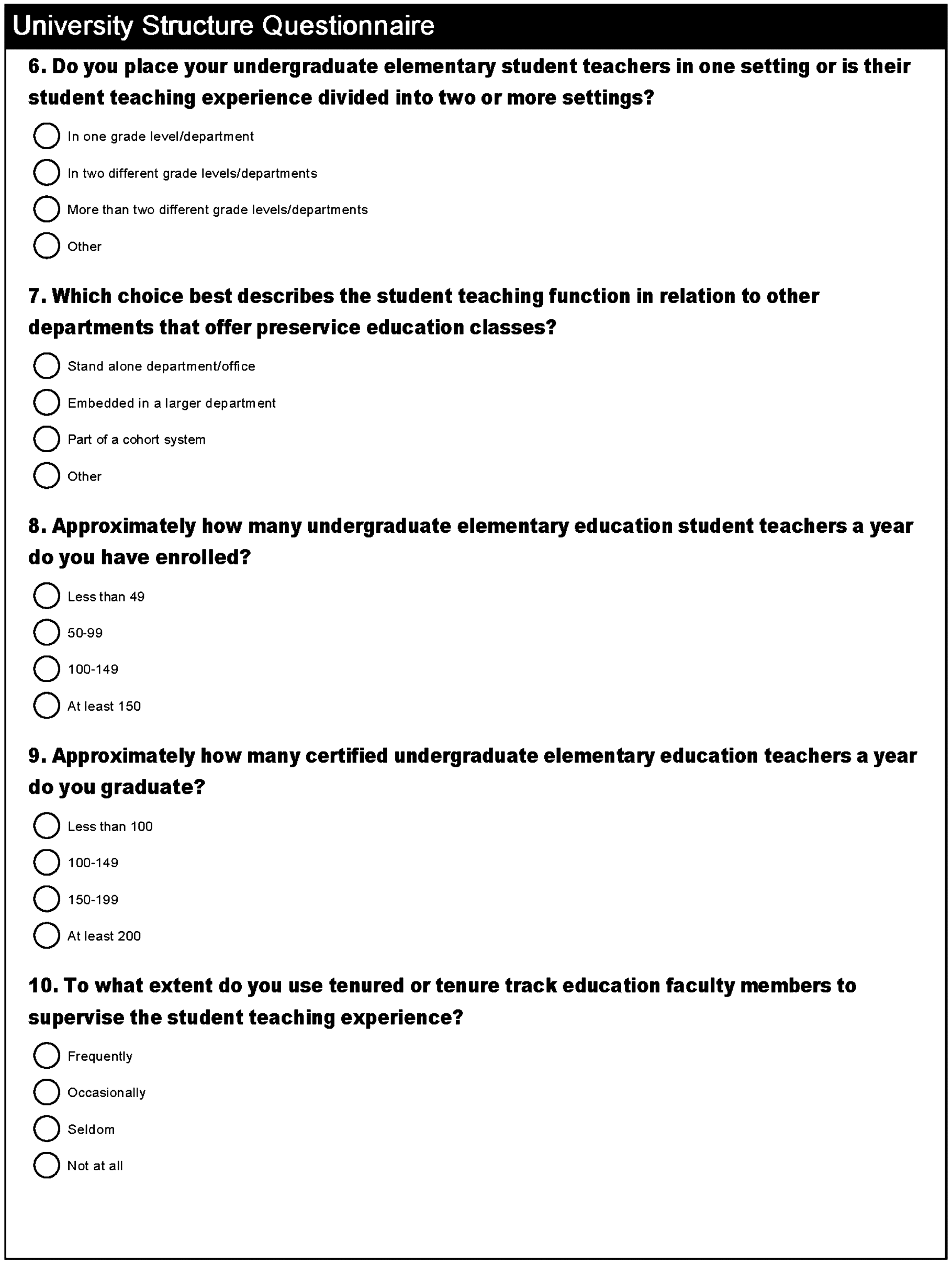

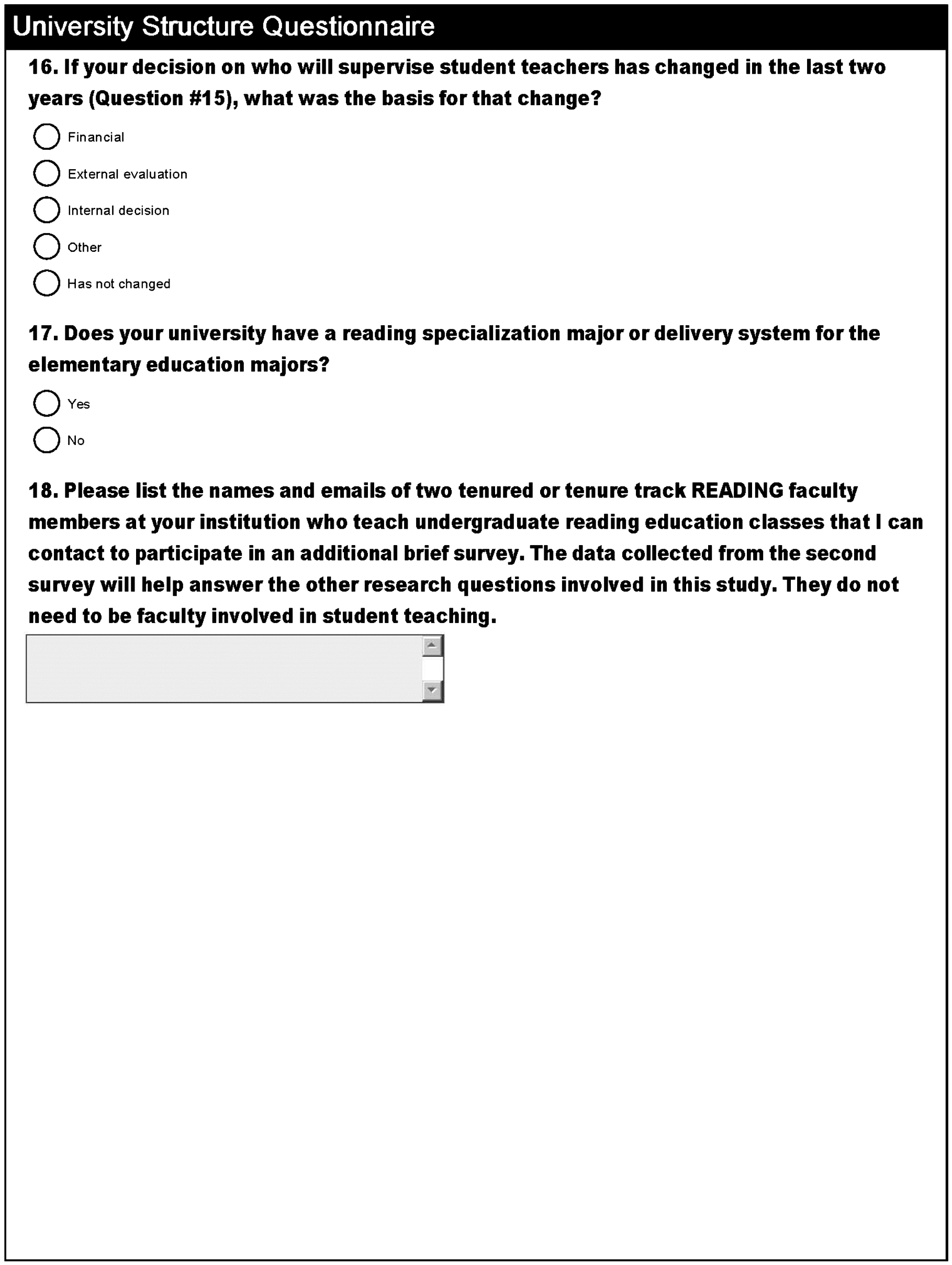
Appendix B
Reading faculty involvement questionnaire
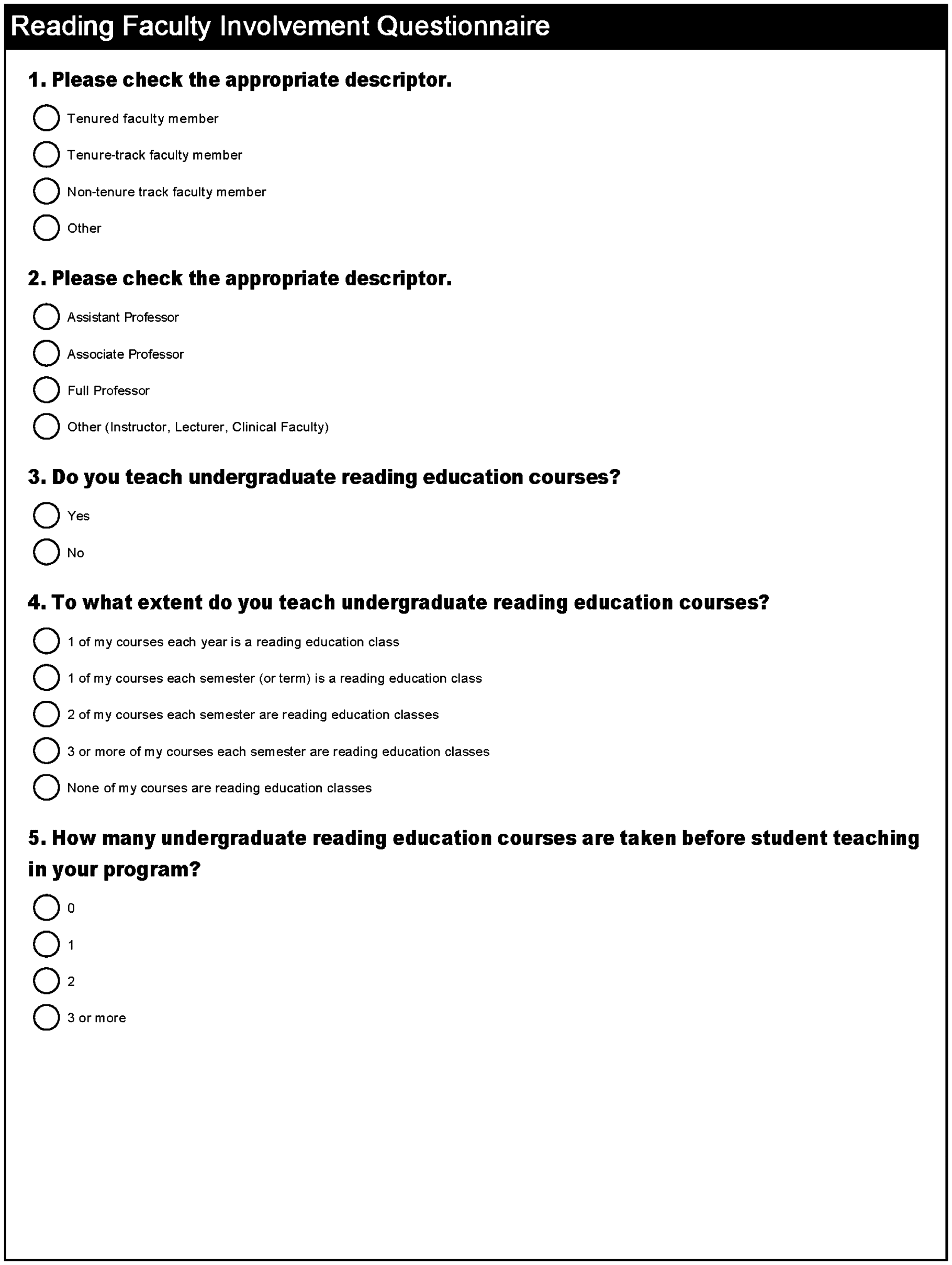
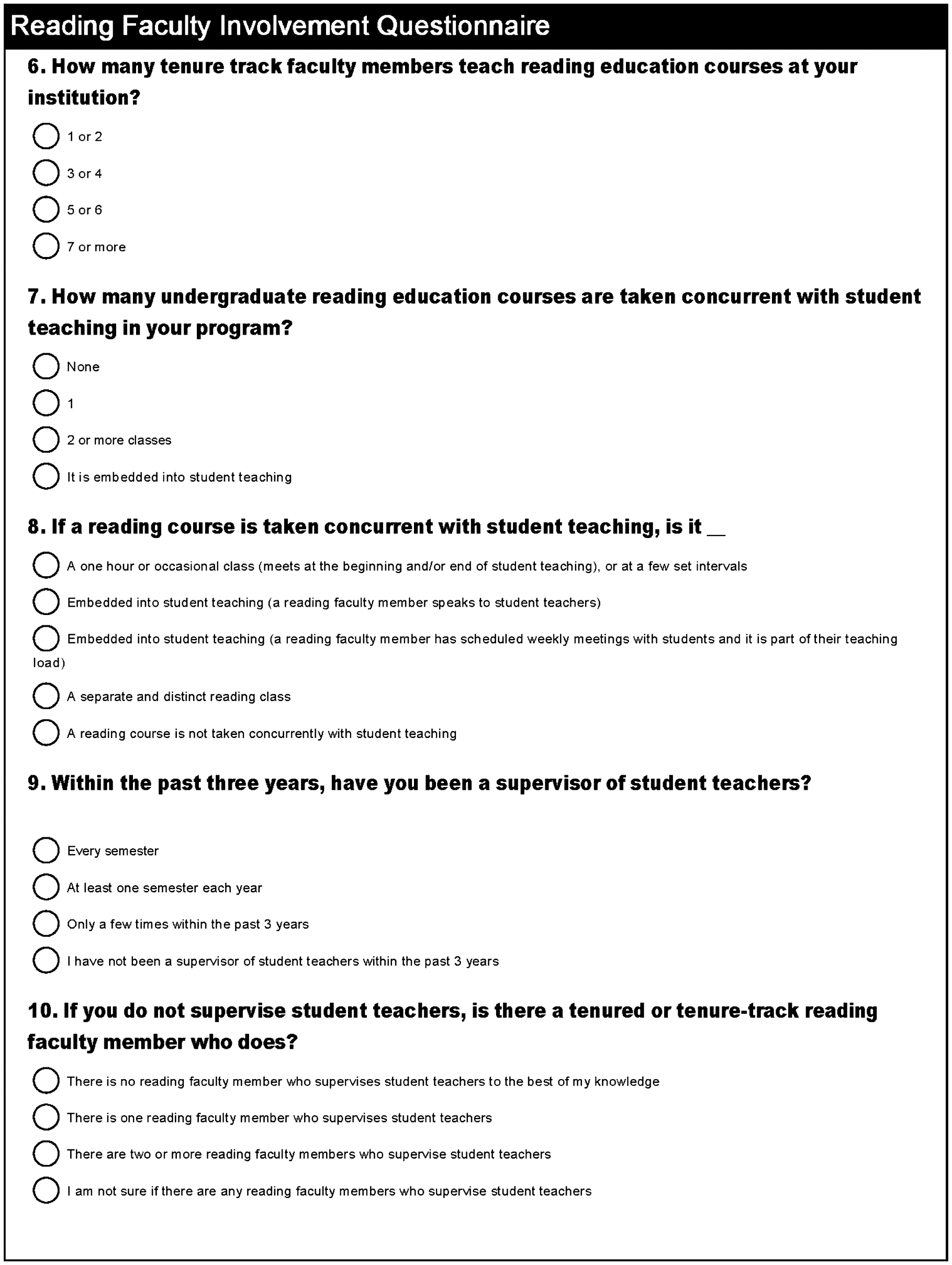
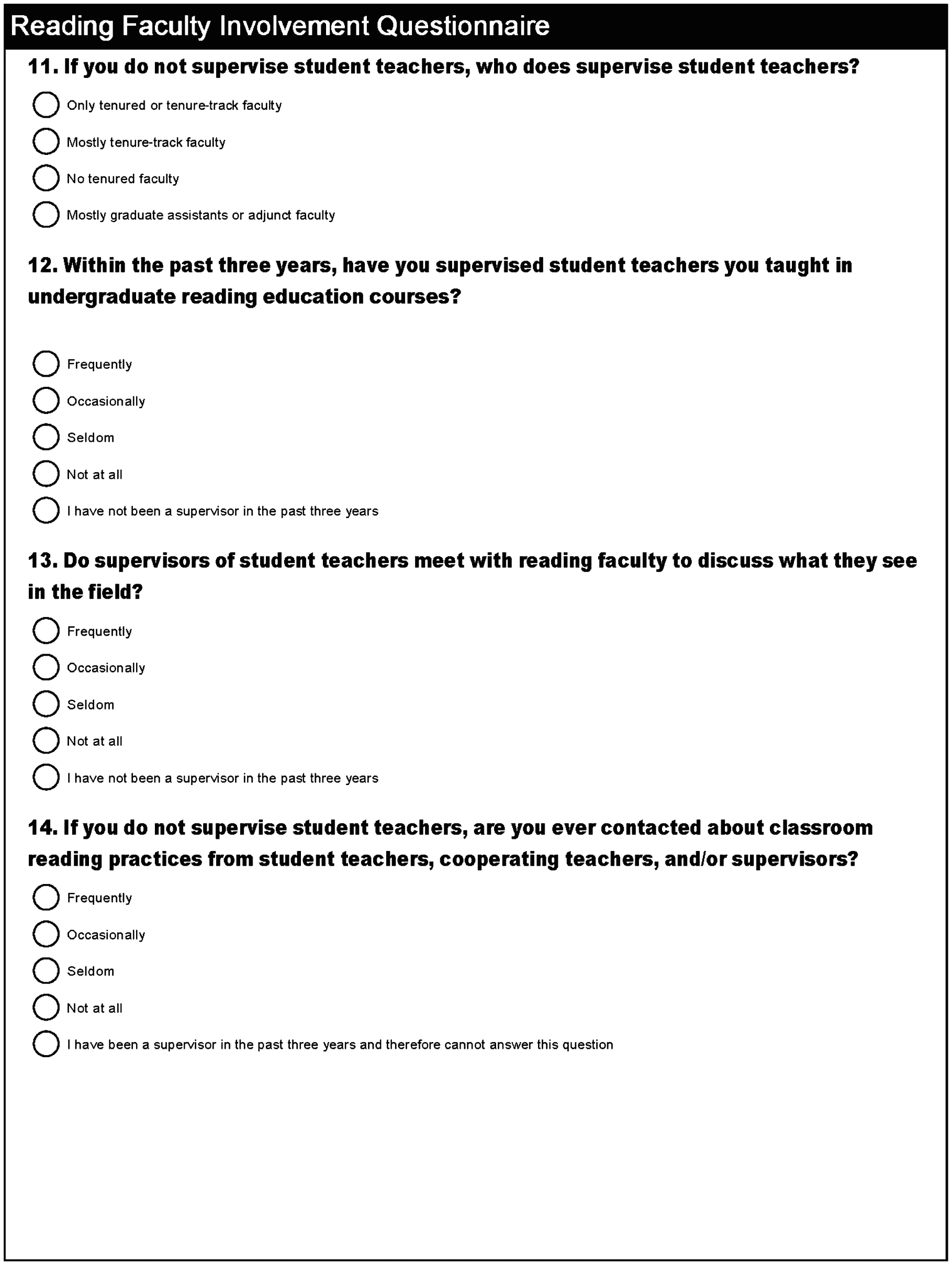
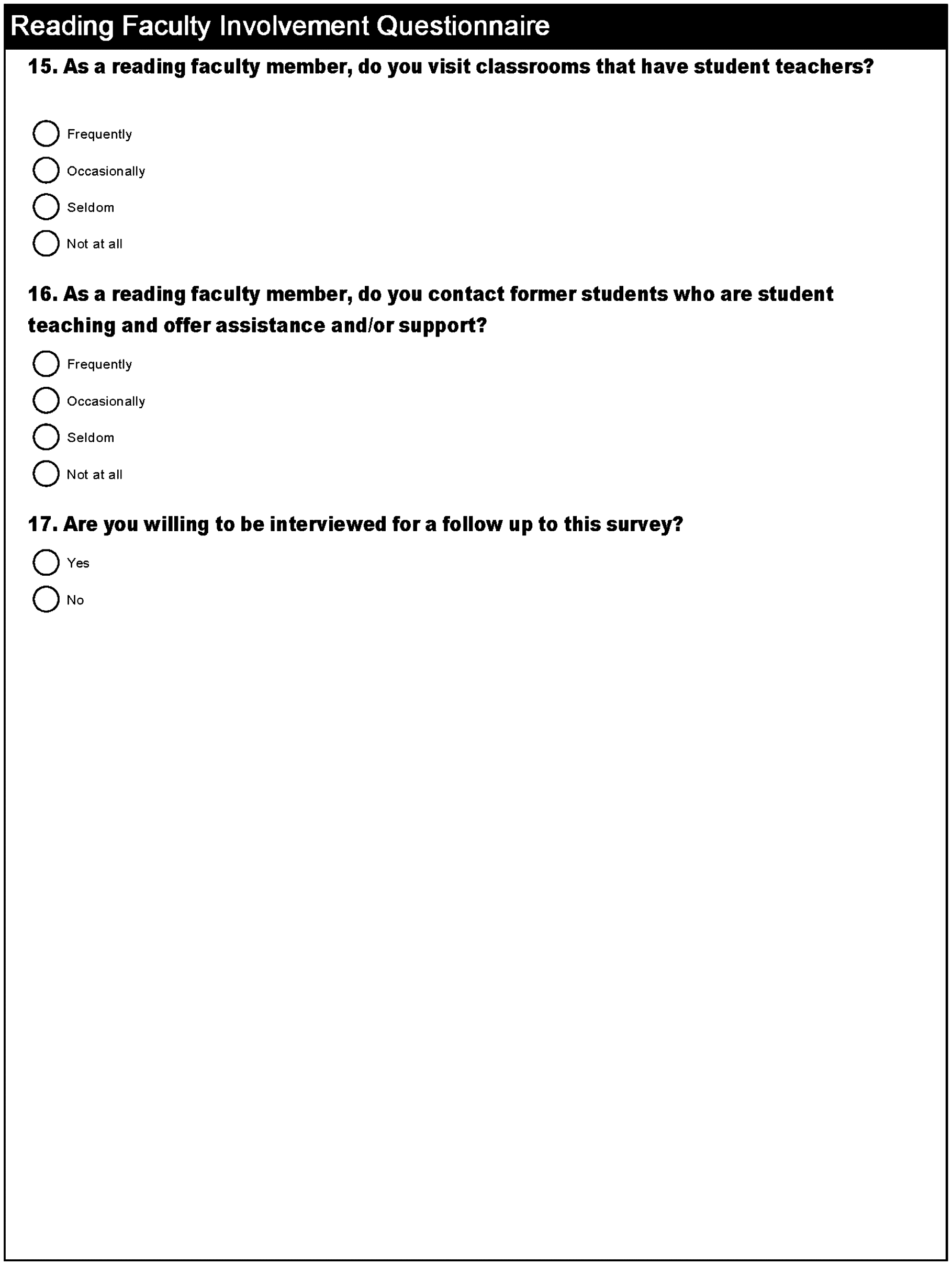
Appendix C
Field experience questionnaire
